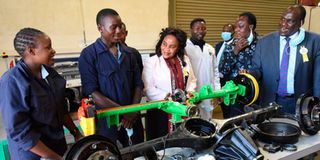Students in technical institutions to benefit from on-the-job training

Dr Margaret Mwakima, Principal Secretary for Vocational and Technical Training (centre), Sheillah Makori (left) and Steve Nato, mechanics students at the Eldoret National Polytechnic during the institution’s 10th Annual International Conference in June.
The Ministry of Education, through the Technical and Vocational Education and Training Authority (TVETA), is working with technical institutions to ensure that students spend more than 60 percent of their training working with relevant industries, in an effort to bridge a worrisome skills gap among graduates.
Through the Kenya Initiative for Vocational Education and Training (KEVET), funded by the German government, four TVET institutions have partnered with several companies to ensure that students get hands-on skills in an industry setting during their time of study.
The programme embraces the dual vocational training approach which allows students to spend 60 percent of their college time working in a company and 40 percent on course work.
In the combination of theory and training, embedded in a real-life work environment, the trainees alternate between training at a TVET institute and in a company.
The TVET institutions include Eastlands College of Technology, Kabete National Polytechnic, Kenya Technical Trainers College and St Kizito Vocational Training Institute.
Vocational training
The programme is being implemented by the Chamber of Industry, Commerce Giessen-Friedberg and the Chamber of Skilled Crafts Frankfurt-Rhein-Main together with Kenyan partners.
So far, about 700 students from the four institutions have been trained.
The dual vocational training will focus on three areas: the automotive, professional scaffolding and Electronics Technician on Devices and System (ETDs)
The colleges have specialists in each area of study, for instance the diploma, certificate and the various artisan courses on offer.
According to TVETA Director General, Dr Kipkirui Langat, with the KeVet project, Kenya and Germany have laid a foundation for various professional training programmes which align vocational education and training with the needs of the country’s economy.
Dr Langat said that the dual vocational training will contribute towards the improvement of employment opportunities for young people in Kenya.
“The demand for qualified specialists is increasing. The economy needs well trained energetic young people,” he said, observing that dual vocational training is the best approach to address the high rate of youth unemployment in the country.
“In the long run, our industry will benefit from a skilled, highly trained workforce which, in turn, provides the solid basis for a company’s competitive edge and innovative strength,” he said.
Dual vocational training
Kenya Vocational Education and Training Project (KeVET) representative, Ms Katharina von Maltzan, explained that the main objective of the project is to develop pilot TVET programmes following the Dual Training System adapted to the Kenyan market and with the participation of private sector stakeholders to improve the qualification of trainees.
“We would now like to encourage more TVET institutes, businesses and business associations to implement and support Dual Vocational Training,” she said.
The project started in December 2014 and will end in September. The dual vocational training project mirrors the competency based education training (CBET) also being implemented across all Tvet institutions.
Kenya is currently adopting the CBET system to address the skills gap among college students. The aim is to increase practice-oriented vocational training in various fields and support the development of occupational standards and related curricula.
The focus in the CBET approach is to link education and training to the skills needed by the employers
The reforms in the TVET sector are aimed at attaining and sustaining a Gross Enrolment Ratio (GER) of 20 percent in TVETS and providing adequate opportunities for accessible competency training.





